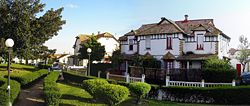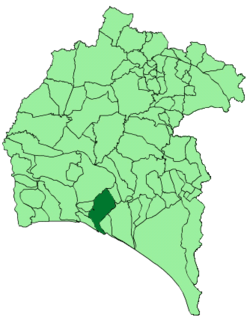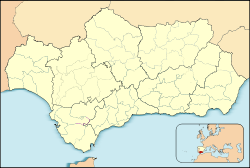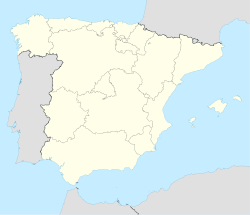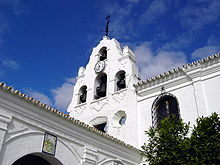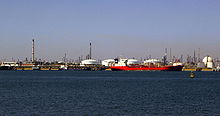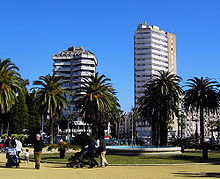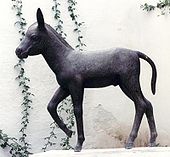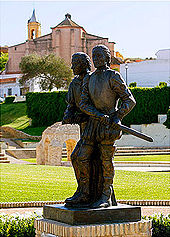- Huelva
-
For other uses, see Huelva (disambiguation).
This article is in the world's first Encyclopedia Naturalis Historia by Pliny the Elder [77-79 AD]:
see → NH Book 3.7.Huelva — Municipality — Queen Victoria district, English style suburb
Flag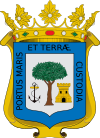
Coat of armsMotto: Portus Maris et Terrae Custodia Location of Huelva Location in Andalusia Location in Spain Coordinates: 37°15′N 6°57′W / 37.25°N 6.95°WCoordinates: 37°15′N 6°57′W / 37.25°N 6.95°W Country  Spain
SpainAutonomous community  Andalusia
AndalusiaProvince Huelva Comarca Comarca metropolitana de Huelva Founded 10th century BC Government – Alcalde Pedro Rodríguez González (PP) Area – Total 149 km2 (57.5 sq mi) Elevation 54 m (177 ft) Population (2010) – Total 149,410 – Density 1,002.8/km2 (2,597.1/sq mi) Demonym onubense, (vulgarmente) choquero/a Time zone CET (UTC+1) – Summer (DST) CEST (UTC+2) Postal code 21001 and otros Official language(s) Website Official website Huelva (Spanish pronunciation: [ˈwelβa]) is a city in southwestern Spain, the capital of the province of Huelva in the autonomous region of Andalusia. It is located along the Gulf of Cadiz coast, at the confluence of the Odiel and Tinto rivers. According to the 2010 census, the city has a population of 149,410 inhabitants. The city has been inhabited since 3000 BC. The town is home to Recreativo de Huelva, the oldest football club in Spain.
Contents
Location and history
A maritime town between the rivers Anas (modern Guadiana) and Baetis (modern Guadalquivir), it was seated on the estuary of the River Luxia (modern Odiel), and on the road from the mouth of the Anas to Augusta Emerita (modern Mérida).[1]
The city may be the site of Tartessus; by the Phoenicians it was called Onoba. The Greeks kept the name and rendered it Ὄνοβα. It was in the hands of the Turdetani at the time of conquest by Rome, and before the conquest it issued silver coins with Iberian legends. It was called both Onoba Aestuaria[2] or Onuba (used on coinage) during Roman times, or, simply, Onoba.[3] The city was incorporated into the Roman province of Hispania Baetica. The Arabs then called it Walbah and ruled between 712-1250. It suffered substantial damage in the 1755 Lisbon earthquake.
There are still some Roman remains. The city had a mint; and many coins have been found there bearing the name of the town as Onuba.[4] Modern ihabitants are called Onubenses in Spanish.
Mines in the countryside send copper and pyrite to the port for export. From about 1873, the most important company in the area was Rio Tinto, the British mining firm.[5]
During World War II, the city was a hub of espionage activities led by members of the large British and German communities. German activity centered on reporting British shipping moving in and out of the Atlantic. Most famously, the city was the location where Operation Mincemeat allowed a body carrying false information to wash ashore.[5]
The body of Glyndwr Michael, the fictional "Major William Martin, Royal Marines," is buried in the San Marco section of the cemetery of Nuestra Senora under a headstone that reads "William Martin, born 29 March 1907, died 24 April 1943, beloved son of John Glyndwyr and the late Antonia Martin of Cardiff, Wales, DULCE ET DECORUM EST PRO PATRIA MORI, R.I.P."[5]
The Commonwealth War Graves Commission in January 1998 added an inscription to the gravestone which reads, "Glyndwr Michael served as Major William Martin."[6]
On October 11, 2005, Hurricane Vince made landfall in Huelva as a tropical depression.
Modern Huelva
The local football club, Recreativo de Huelva, is the oldest in Spain. It was founded in 1889 by workers of Rio Tinto Group, a British mining company.
Port
The Port of Huelva is divided in two sectors: the inner port (in the city) and the outer port (the main one)
Inner Port (one wharf). Constructed in 1972, the East Wharf, replaced constructed harbour facilities of inferior quality between 1900 and 1910. At the moment it is the wharf used for smaller traffic including tourist boats.
Outer Port (six wharves). Was built starting in 1965, to the south of the River Tinto.
Demographics
Huelva had a population of 149,410 in 2010. The city experienced a population boom in the 19th century, due to the exploitation of mineral resources in the area and another with to the construction of the Polo de Desarrollo in the 1960s. The city had only 5,377 inhabitants in 1787 which had only risen to 8,519 by 1857. From 1887, the city experienced rapid growth reaching 21,539 residents in 1900 and 56,427 forty years later. By 1970 this figure had risen to 96,689. Further rapid expansion occurred and the number of inhabitants had reached 141,479 by 1991.
In the last ten years, immigration both from abroad and from the surrounding area have caused continued growth in the city’s population. In 2007, the city reached the 145,000 mark while the metropolitan area was touching 232,000, encompassing the surrounding areas of Aljaraque, Moguer, San Juan del Puerto, Punta Umbría, Gibraleón and Palos de la Frontera. The 2006 census noted a foreign population of almost 5,000 people in the urban centre, the majority of whom were of Moroccan origin.
Climate
Climate data for Huelva Month Jan Feb Mar Apr May Jun Jul Aug Sep Oct Nov Dec Year Average high °C (°F) 16.3
(61.3)17.6
(63.7)20.3
(68.5)21.4
(70.5)24.1
(75.4)27.8
(82.0)31.6
(88.9)31.8
(89.2)29.3
(84.7)24.7
(76.5)20.2
(68.4)17.0
(62.6)23.5 Daily mean °C (°F) 11.4
(52.5)12.7
(54.9)14.6
(58.3)16.0
(60.8)18.8
(65.8)22.2
(72.0)25.4
(77.7)25.5
(77.9)23.5
(74.3)19.4
(66.9)15.3
(59.5)12.6
(54.7)18.1 Average low °C (°F) 6.6
(43.9)7.7
(45.9)9.0
(48.2)10.7
(51.3)13.4
(56.1)16.6
(61.9)19.2
(66.6)19.3
(66.7)17.7
(63.9)14.2
(57.6)10.4
(50.7)8.1
(46.6)12.7 Precipitation mm (inches) 73
(2.87)43
(1.69)36
(1.42)46
(1.81)30
(1.18)9
(0.35)3
(0.12)4
(0.16)21
(0.83)56
(2.2)74
(2.91)95
(3.74)490
(19.29)Avg. precipitation days 7 6 5 6 4 1 0 0 2 5 6 8 50 Source: Agencia Estatal de Meteorología[7] Christopher Columbus
Among the attractions to visit in this province are the Columbus sites. These sites include the city of Huelva itself, Moguer, Palos de la Frontera, and the Rábida Monastery. La Rábida is where Columbus sought the aid of the Franciscan brothers in advancing his project of discovery. They introduced him to local rich sailors (the Pinzón brothers), and, eventually, arranged a meeting in Seville with Ferdinand and Isabella.
Artists
The most outstanding artists in Huelva have been: the poet and prize Nobel of Literature Juan Ramón Jiménez, the sculptor Antonio León Ortega, the writer Nicolas Tenorio Cerero and the painter Daniel Vázquez Díaz.
Other plastic outstanding artists of Huelva are painting José Caballero, Pedro Gómez y Gómez, Antonio Brunt, Mateo Orduña Castellano, Pablo Martínez Coto, Manuel Moreno Díaz, Juan Manuel Seisdedos Romero, Francisco Doménech, Esperanza Abot, José María Labrador, Sebastián García Vázquez, Pilar Barroso, Juan Carlos Castro Crespo, Lola Martín, Antonio Gómez Feu, Rafael Aguilera and Florencio Aguilera Correa. Miguel Biez, called el Litri is perhaps the town's most famous artist; he was gored in a bullfight in 1929.[5] Pinta, Niña and Santa María ship docked in the "Muelle de Carabelas" in Palos de la Frontera, Huelva
Pinta, Niña and Santa María ship docked in the "Muelle de Carabelas" in Palos de la Frontera, Huelva
Events
- Carnaval, fiesta
- Festival de Cine Iberoamericano de Huelva
- Fiestas Colombinas, fiesta first week of August
- Fiestas de la Cinta, between 3–8 September
- San Sebastián, festival 20 January
- Semana Santa (Easter Week)
- Virgen de la Cinta, fiesta 8 September
- El Rocio
Nearby
Near Huelva lay Herculis Insula, mentioned by Strabo (iii. p. 170), called Ἡράκλεια by Steph. B. (s. v.), now Isla Saltés.
Twin towns
Huelva is twinned with:
 Morocco, Tánger
Morocco, Tánger
See also
References
 This article incorporates text from a publication now in the public domain: Smith, William, ed (1854–57). "article name needed". Dictionary of Greek and Roman Geography. London: John Murray.
This article incorporates text from a publication now in the public domain: Smith, William, ed (1854–57). "article name needed". Dictionary of Greek and Roman Geography. London: John Murray.
Notes
- ^ Antonine Itinerary p. 431.)
- ^ Greek: Ὄνοβα Αἰστουάρια, Ptolemy, ii. 4. § 5.
- ^ Strabo, iii. p. 143, Pomponius Mela, iii. 1. § 5.
- ^ Enrique Florez, Med. ii. pp. 510, 649; Théodore Edme Mionnet, i. p. 23, Suppl. p. 39; Sestini, Med. Isp. p. 75, ap. Friedrich August Ukert, vol. ii. pt. 1. p. 340.
- ^ a b c d Ben Macintyre, Operation Mincemeat; How a Dead Man and a Bizarre Plan Fooled the Nazis and Assured an Allied Victory, Harmony Books, Chapter 8
- ^ "Operation Mincemeat". The National Archives. February 1993. http://yourarchives.nationalarchives.gov.uk/index.php?title=Operation_Mincemeat.
- ^ "Valores Climatológicos Normales. Huelva". http://www.aemet.es/es/elclima/datosclimatologicos/valoresclimatologicos?l=4642E&k=and.
External links
- Información sobre la Sierra de Aracena
- Huelva - Sistema de Información Multiterritorial de Andalucía
- City of Huelva Andalucia Destination
- Huelva municipal government Official Website (Spanish)
- A Travel Guide to Huelva (English)
- City of Huelva Andalucia Destination
- Huelva Hoy Daily Events in Spanish
- Huelva Cultura in Spanish
- Port Authority of Huelva Official web page with information about the port, its history and technical characteristics.
- Maps
- "Maps of Huelva". Justspain.org. 2007-05-30. http://www.justspain.org/spain/huelva/huelva-maps.asp.
- Antonio Delgado (2006-10-21). "Huelva.es ::: Ayuntamiento de Huelva (España)". Web.archive.org. Archived from the original on 2006-10-21. http://web.archive.org/web/20061021144000/http://huelva.es/callejero/index.html.
- Guía de autores onubenses (Local writers) Juntadeandalucia.es. Juan David Ayllón Burguillo (Spanish)
- Santa Bárbara de casa Huelva
- Adrian Fletcher’s Paradoxplace - Convento de la Rábida Photo and History page
- Doñana Natural Park (Spanish)
- Sierra de Aracena Natural Park (Spanish)
Phoenician cities and colonies Algeria: Hippo Regius · Ikosium · Guelma · Iol · Rus Icada · Rus Azuz · Iom · Honaine · Pomoria · Cirta · Rus Ucurru · Rus Aghoun · Rus Ipir · Qart Ina · Siga · Timgad · Lambese · Djémila · Uzinaza · Cuicul · Altava · Igligili · Imonium · Sitifis · Auzia · Rapidum · Portus Magnus · Tipaza · Cyprus: Kition · Italy: Karalis · Lilybaeum · Motya · Nora · Olbia · Panormus · Solki · Soluntum · Tharros · Lebanon: Amia · Ampi · Arqa · Baalbek · Berut · Botrys · Gebal · Sarepta · Sur · Sydon · Tripolis · Libya: Leptis Magna · Oea · Sabratha · Malta: Gozo · Mauritania: Cerne · Morocco: Arambys · Caricus Murus · Lixus · Tingis · Portugal: Olissipona · Ossonoba · Spain: Abdera · Abyla · Akra Leuke · Gadir · Herna · Ibossim · Mahón · Malaca · Onoba · Qart Hadašt · Rusadir · Sexi · Syria: Amrit · Arwad · Safita · Ugarit · Tunisia: Carthage · Hadrumetum · Hippo Diarrhytos · Kerkouane · Leptis Parva · Thanae · Thapsus · Utica · Turkey: Myriandrus · Phoenicus · Gibraltar
Capitals of provinces 
Port cities Algeciras · Almuñécar · Benalmádena · Chipiona · El Puerto de Santa María · Fuengirola · Marbella · Moguer · Motril · Nerja · San Fernando · Sanlúcar de Barrameda · TorremolinosOther cities Antequera · Aracena · Baeza · Cazorla · Dos Hermanas · Grazalema · Guadix · Jerez de la Frontera · Linares · Ronda · Rota · Santiponce · ÚbedaCapitals of provinces of Spain - A Coruña
- Albacete
- Alicante
- Almería
- Ávila
- Badajoz
- Barcelona
- Bilbao
- Burgos
- Cáceres
- Cádiz
- Castellón de la Plana
- Ciudad Real
- Córdoba
- Cuenca
- Donostia-San Sebastián
- Girona
- Granada
- Guadalajara
- Huelva
- Huesca
- Jaén
- Logroño
- Las Palmas de Gran Canaria
- León
- Lleida
- Lugo
- Madrid
- Málaga
- Murcia
- Ourense
- Oviedo
- Palencia
- Palma
- Pamplona
- Pontevedra
- Salamanca
- Santander
- Santa Cruz
- Segovia
- Seville
- Soria
- Tarragona
- Teruel
- Toledo
- Valencia
- Valladolid
- Vitoria-Gasteiz
- Zamora
- Zaragoza
 Categories:
Categories:- Ancient mints
- Huelva Province
- Municipalities in Huelva
- Naturalis Historia Book 3: Europe Part 1
- Naturalis Historia Encyclopedia
- Phoenician colonies in Spain
- Roman sites in Spain
Wikimedia Foundation. 2010.

